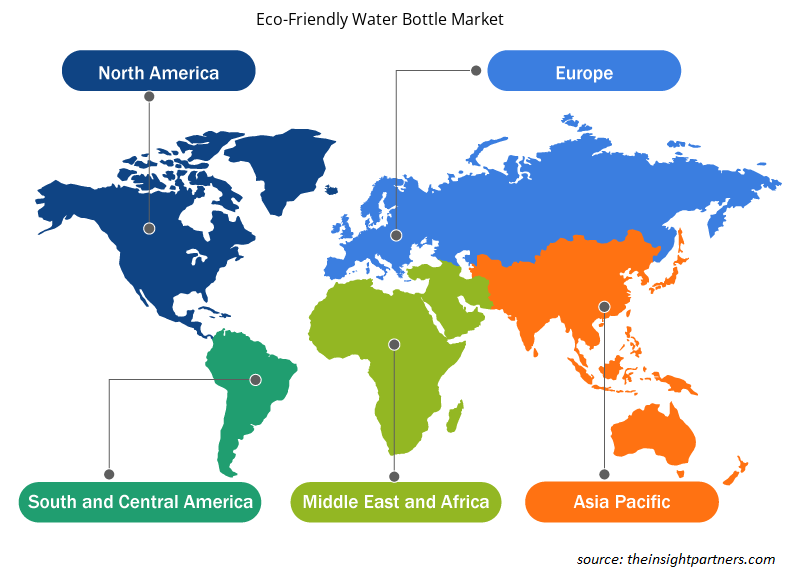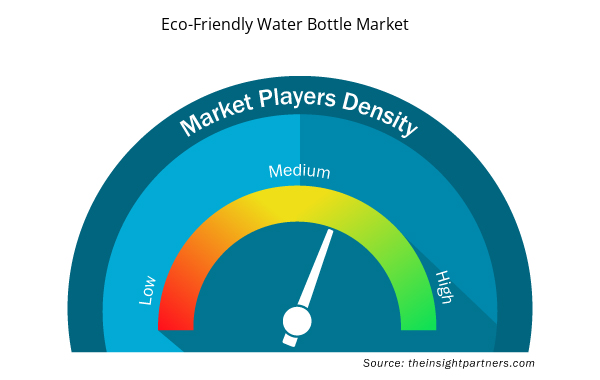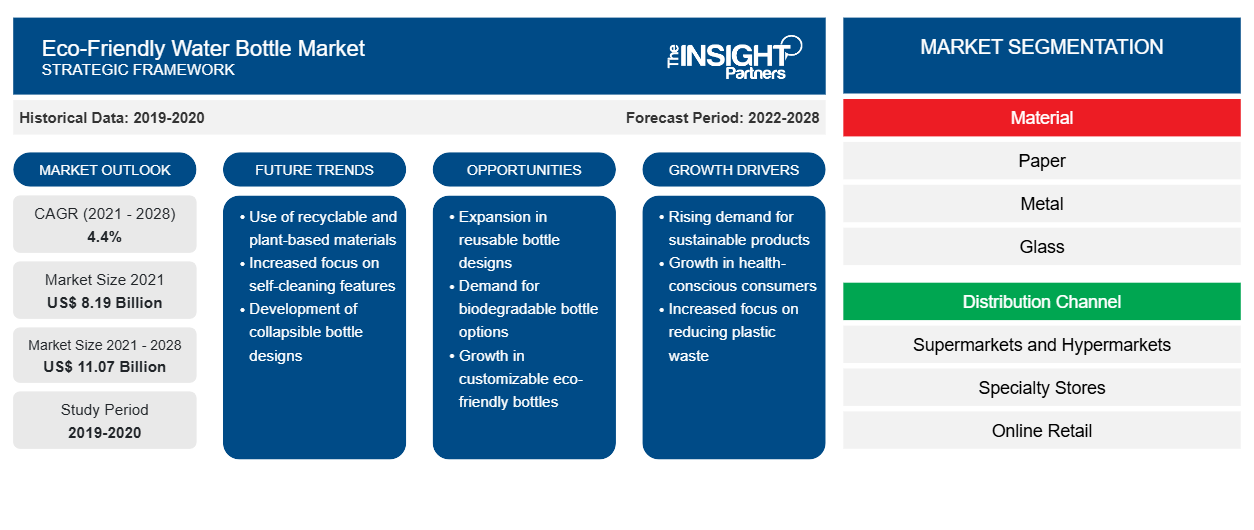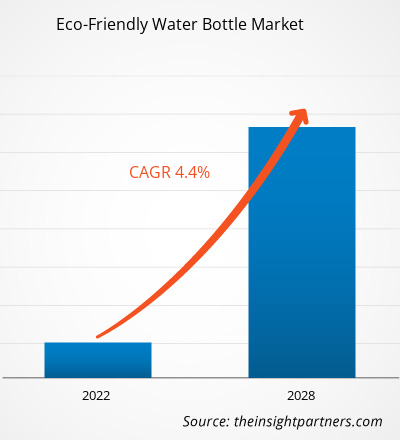Der Markt für umweltfreundliche Wasserflaschen soll von 8.193,19 Millionen US-Dollar im Jahr 2021 auf 11.068,71 Millionen US-Dollar im Jahr 2028 anwachsen; für den Zeitraum 2021–2028 wird mit einer durchschnittlichen jährlichen Wachstumsrate von 4,4 % gerechnet.
Das Wachstum des Marktes wird dem schnell wachsenden Umweltbewusstsein der Verbraucher zugeschrieben. Verbraucher ersetzen proaktiv Einweg-Plastikwasserflaschen durch umweltfreundliche Wasserflaschen, um die Ansammlung von Plastik in der Umwelt zu verhindern. Der Trend wird durch Social-Media-Kanäle unterstützt, auf denen Influencer die Verwendung wiederverwendbarer Wasserflaschen als ethische Wahl fördern .
Im Jahr 2020 hatte der asiatisch-pazifische Raum den größten Anteil am Markt für umweltfreundliche Wasserflaschen und wird im Prognosezeitraum voraussichtlich die höchste durchschnittliche jährliche Wachstumsrate verzeichnen . Der Markt im asiatisch-pazifischen Raum ist in China, Indien, Japan, Südkorea und Australien unterteilt. Länder wie Südkorea, China und Japan gehören aufgrund der wachsenden Bevölkerung und der daraus resultierenden Nachfrage nach Konsumgütern zu den Hauptakteuren in dieser Region. Darüber hinaus sind die schnelle Urbanisierung, die bemerkenswerte wirtschaftliche Entwicklung, die kulturelle Vielfalt und die zunehmende Akzeptanz von Hightech-Trends die Faktoren, die das Wachstum des Marktes für umweltfreundliche Wasserflaschen im asiatisch-pazifischen Raum begünstigen.
Passen Sie diesen Bericht Ihren Anforderungen an
Sie erhalten kostenlos individuelle Anpassungen an jedem Bericht, einschließlich Teilen dieses Berichts oder einer Analyse auf Länderebene, eines Excel-Datenpakets sowie tolle Angebote und Rabatte für Start-ups und Universitäten.
- Holen Sie sich die wichtigsten Markttrends aus diesem Bericht.Dieses KOSTENLOSE Beispiel umfasst eine Datenanalyse von Markttrends bis hin zu Schätzungen und Prognosen.
Auswirkungen der COVID-19-Pandemie auf den Markt für umweltfreundliche Wasserflaschen
Die COVID-19-Pandemie hat die Betriebseffizienz des Fertigungssektors aufgrund längerer Lockdowns in verschiedenen Regionen, der Schließung von Produktionseinheiten, Reisebeschränkungen, Beschränkungen des internationalen Handels und der Lieferketten sowie Rohstoffknappheit erheblich beeinträchtigt. Diese Faktoren haben auch das Marktwachstum aufgrund steigender Rohstoffpreise, Arbeitskräftemangel und Instabilität an der Finanzfront gebremst. Die Unternehmen holen jedoch auf, da zuvor verhängte Beschränkungen in verschiedenen Ländern mit der Einführung und Verabreichung von COVID-19-Impfstoffen gelockert werden. Darüber hinaus planen die Regierungen verschiedener Länder den Aufbau einer modernen und technologisch fortschrittlichen Infrastruktur, um die wirtschaftlichen Auswirkungen der Pandemie abzumildern. Darüber hinaus nahmen die Verbraucher in den Spätphasen der Pandemie an Freizeitaktivitäten im Freien teil, was die Nachfrage nach umweltfreundlichen Wasserflaschen förderte.
Markteinblicke,
die technologische Entwicklungen anregen, treiben das Wachstum des Marktes für umweltfreundliche Wasserflaschen voran
Umweltfreundliche Wasserflaschen werden aus Glas, pflanzlichen Kunststoffen, Papier und anderen nachhaltigen Rohstoffen hergestellt. Die Hersteller konzentrieren sich bei der Herstellung umweltfreundlicher Wasserflaschen auf die Verwendung von biobasierten Kunststoffen, wiederverwertbaren Metallen und Glas . Biobasierte Kunststoffe werden aus erneuerbaren Materialien wie Soja und Mais und nicht aus fossilen Brennstoffen hergestellt. Diese Produkte reduzieren die Abhängigkeit von fossilen Brennstoffen durch die Verwendung erneuerbarer Ressourcen. Umweltfreundliche Wasserflaschen werden zunehmend in verschiedenen gewerblichen Bereichen eingesetzt, beispielsweise in Werkstätten, Poolhäusern, Hotels, Fitnessstudios und anderen Sportanlagen, Spas und Schönheitssalons sowie Krankenhäusern und medizinischen Einrichtungen.
Laut den im Jahr 2020 veröffentlichten Daten der International Bottled Water Association ( IBWA ) verbrauchten die Amerikaner im Jahr 2020 15 Milliarden Gallonen Flaschenwasser. Dies zeigt, dass Anbieter umweltfreundlicher Wasserflaschen ein Marktpotenzial haben, um ihre Reichweite zu erweitern. Es ermutigt die Hersteller, neue Technologien zur Herstellung umweltfreundlicher Lösungen einzusetzen .
Einblicke in Vertriebskanäle
Basierend auf den Vertriebskanälen ist der globale Markt für umweltfreundliche Wasserflaschen in Supermärkte und Hypermärkte, Fachgeschäfte, Online-Einzelhandel und andere unterteilt. Im Jahr 2020 hatte das Segment Supermärkte und Hypermärkte den größten Umsatzanteil, und das Segment Online-Einzelhandel dürfte im Prognosezeitraum die höchste durchschnittliche jährliche Wachstumsrate verzeichnen. Supermärkte und Hypermärkte sind in allen Regionen leicht zugänglich und standortmäßig weit verbreitet. Sie setzen attraktive Merchandising-Techniken ein, die die Verbraucher ansprechen und so höhere Umsätze für umweltfreundliche Wasserflaschen erzielen.eco-friendly water bottle market is segmented into supermarkets and hypermarkets, specialty stores, online retail, and others. In 2020, the supermarkets and hypermarkets segment accounted for the largest revenue share, and the online retail segment is expected to register the highest CAGR during the forecast period. Supermarkets and hypermarkets are easily accessible in all regions and widespread in terms of locations. They adopt attractive merchandising techniques that appeal to consumers, thus generating higher sales for eco-friendly water bottles.
Chilly's; S'well; Ocean Bottle; Corkcicle; Hydro Flask; Bottles Società Benefit SrlPIVA; Frank Green; Qwetch; Klean Kanteen; und Kinto Co., Ltd. gehören zu den Akteuren auf dem Markt für umweltfreundliche Wasserflaschen. Diese Unternehmen bieten dem Markt ein breites Produktportfolio. Viele Unternehmen auf diesem Markt sind in Entwicklungsregionen vertreten, was ihnen lukrative Möglichkeiten bietet. Die Marktteilnehmer entwickeln qualitativ hochwertige und innovative Produkte, um die Anforderungen der Kunden zu erfüllen.; S'well; Ocean Bottle; Corkcicle; Hydro Flask; Bottles Società Benefit S.r.l. P.IVA; Frank Green; Qwetch; Klean Kanteen; and Kinto Co., Ltd. are among the players operating in the eco-friendly water bottle market. These companies provide a wide range of product portfolio for the market. Many companies in this market have presence in developing regions, which provides lucrative opportunities to them. The market players are developing high-quality and innovative products to meet the customer’s requirements.
Regionale Einblicke in den Markt für umweltfreundliche Wasserflaschen
Die regionalen Trends und Faktoren, die den Markt für umweltfreundliche Wasserflaschen während des gesamten Prognosezeitraums beeinflussen, wurden von den Analysten von Insight Partners ausführlich erläutert. In diesem Abschnitt werden auch Marktsegmente und Geografien für umweltfreundliche Wasserflaschen in Nordamerika, Europa, im asiatisch-pazifischen Raum, im Nahen Osten und Afrika sowie in Süd- und Mittelamerika erörtert.

- Holen Sie sich die regionalen Daten für den Markt für umweltfreundliche Wasserflaschen
Umfang des Marktberichts über umweltfreundliche Wasserflaschen
| Berichtsattribut | Details |
|---|---|
| Marktgröße im Jahr 2021 | 8,19 Milliarden US-Dollar |
| Marktgröße bis 2028 | 11,07 Milliarden US-Dollar |
| Globale CAGR (2021 - 2028) | 4,4 % |
| Historische Daten | 2019-2020 |
| Prognosezeitraum | 2022–2028 |
| Abgedeckte Segmente | Nach Material
|
| Abgedeckte Regionen und Länder | Nordamerika
|
| Marktführer und wichtige Unternehmensprofile |
|
Marktdichte umweltfreundlicher Wasserflaschen: Auswirkungen auf die Geschäftsdynamik verstehen
Der Markt für umweltfreundliche Wasserflaschen wächst rasant, angetrieben durch die steigende Nachfrage der Endverbraucher aufgrund von Faktoren wie sich entwickelnden Verbraucherpräferenzen, technologischen Fortschritten und einem größeren Bewusstsein für die Vorteile des Produkts. Mit steigender Nachfrage erweitern Unternehmen ihr Angebot, entwickeln Innovationen, um die Bedürfnisse der Verbraucher zu erfüllen, und nutzen neue Trends, was das Marktwachstum weiter ankurbelt.
Die Marktteilnehmerdichte bezieht sich auf die Verteilung von Firmen oder Unternehmen, die in einem bestimmten Markt oder einer bestimmten Branche tätig sind. Sie gibt an, wie viele Wettbewerber (Marktteilnehmer) in einem bestimmten Marktraum im Verhältnis zu seiner Größe oder seinem gesamten Marktwert präsent sind.
Die wichtigsten Unternehmen auf dem Markt für umweltfreundliche Wasserflaschen sind:
- Kühl
Haftungsausschluss : Die oben aufgeführten Unternehmen sind nicht in einer bestimmten Reihenfolge aufgeführt.

- Erhalten Sie einen Überblick über die wichtigsten Akteure auf dem Markt für umweltfreundliche Wasserflaschen
Bericht-Spotlights
- Fortschrittliche Branchentrends auf dem Markt helfen den Akteuren bei der Entwicklung wirksamer langfristiger Strategien
- In Industrie- und Entwicklungsländern angewandte Strategien für Unternehmenswachstum
- Quantitative Analyse des Marktes von 2019 bis 2028
- Schätzung der weltweiten Nachfrage nach umweltfreundlichen Wasserflaschen
- PEST-Analyse zur Veranschaulichung der Leistungsfähigkeit von Einkäufern und Lieferanten in der Konsumgüterindustrie
- Aktuelle Entwicklungen zum Verständnis des wettbewerbsorientierten Marktszenarios
- Markttrends und -aussichten sowie Faktoren, die das Wachstum des Marktes für umweltfreundliche Wasserflaschen vorantreiben und bremsen
- Unterstützung im Entscheidungsprozess durch Aufzeigen von Marktstrategien, die das kommerzielle Interesse untermauern und zum Marktwachstum führen
- Die Marktgröße für umweltfreundliche Wasserflaschen an verschiedenen Knotenpunkten
- Detaillierte Übersicht und Segmentierung des Marktes sowie der Dynamik der umweltfreundlichen Wasserflaschenindustrie
- Größe des Marktes für umweltfreundliche Wasserflaschen in verschiedenen Regionen mit vielversprechenden Wachstumschancen
Die „Globale Marktanalyse für umweltfreundliche Wasserflaschen bis 2028“ ist eine spezialisierte und eingehende Studie der Chemie- und Materialindustrie mit besonderem Schwerpunkt auf der globalen Trendanalyse des Marktes für umweltfreundliche Wasserflaschen. Der Bericht soll einen Überblick über den Markt mit detaillierter Marktsegmentierung geben. Der Markt für umweltfreundliche Wasserflaschen ist nach Material, Vertriebskanal und Geografie segmentiert. Nach Material ist der Markt in Papier, Metall, Glas und andere unterteilt. Nach Vertriebskanal ist der Markt in Supermärkte und Hypermärkte, Fachgeschäfte, Online-Einzelhandel und andere unterteilt. Nach Geografie ist der Markt für umweltfreundliche Wasserflaschen grob in Nordamerika, Europa, Asien-Pazifik (APAC), den Nahen Osten und Afrika (MEA) sowie Süd- und Mittelamerika (SAM) unterteilt.
Firmenprofile
- Chili's
- Quellen
- Ozeanflasche
- Korkenzieher
- Hydro-Flasche
- Flaschen Società Benefit SrlPIVA
- Frank Green
- Qwetch
- Klean Kanteen
- Kinto Co., Ltd.
- Historische Analyse (2 Jahre), Basisjahr, Prognose (7 Jahre) mit CAGR
- PEST- und SWOT-Analyse
- Marktgröße Wert/Volumen – Global, Regional, Land
- Branche und Wettbewerbsumfeld
- Excel-Datensatz



Report Coverage
Revenue forecast, Company Analysis, Industry landscape, Growth factors, and Trends

Segment Covered
This text is related
to segments covered.

Regional Scope
North America, Europe, Asia Pacific, Middle East & Africa, South & Central America

Country Scope
This text is related
to country scope.
Häufig gestellte Fragen
The global eco-friendly bottle market is expanding rapidly due to increased public and government awareness about environmental protection. The crucial driver propelling the market is the increased availability of a diverse selection of items from various brands on e-commerce platforms with services such as free delivery and promotional discounts.
Based on material, the metal segment is expected to be the fastest-growing segment during the forecast period. The characteristics of metal water bottles, such as durability and reusability, are expected to propel the eco-friendly water bottle market growth.
In 2020, the supermarkets and hypermarkets segment held the largest market share. The availability of a wide variety of products under one roof attract customers to shop at these stores. Furthermore, consumer-oriented product placement that aids them in selecting and purchasing the product faster than waiting for its delivery, as is the case with online purchases.
In 2020, the metal segment held the largest market share. Metal acts as a better shielding barrier than any plastic material. Metal is abundant in nature and can be recycled again with minimal energy waste during manufacture, lowering the overall cost of production for eco-friendly water bottles. These factors contribute to the growth of the eco-friendly water bottle market.
The major players operating in the eco-friendly water bottles market are Chilly's, S'well, Ocean Bottle, Corkcicle, Hydro Flask, 24 Bottles Società Benefit S.r.l. P.IVA, Frank Green, Qwetch, Klean Kanteen, and Kinto Co., Ltd.
In 2020, Asia-Pacific accounted for the largest share of the global eco-friendly water bottles market. The eco-friendly water bottle market has expanded significantly as governments and consumers have become more concerned about environmental issues. Manufacturers' increasing investments on research and development are crucial factors impacting the eco-friendly water bottle market positively.
Trends and growth analysis reports related to Consumer Goods : READ MORE..
The List of Companies - Eco-Friendly Water Bottle Market
- Chilly’s
- S'well
- Ocean Bottle
- Corkcicle
- Hydro Flask
- 24 Bottles Società Benefit S.r.l. P.IVA
- Frank Green
- Qwetch
- Klean Kanteen
- Kinto Co., Ltd.
The Insight Partners performs research in 4 major stages: Data Collection & Secondary Research, Primary Research, Data Analysis and Data Triangulation & Final Review.
- Data Collection and Secondary Research:
As a market research and consulting firm operating from a decade, we have published and advised several client across the globe. First step for any study will start with an assessment of currently available data and insights from existing reports. Further, historical and current market information is collected from Investor Presentations, Annual Reports, SEC Filings, etc., and other information related to company’s performance and market positioning are gathered from Paid Databases (Factiva, Hoovers, and Reuters) and various other publications available in public domain.
Several associations trade associates, technical forums, institutes, societies and organization are accessed to gain technical as well as market related insights through their publications such as research papers, blogs and press releases related to the studies are referred to get cues about the market. Further, white papers, journals, magazines, and other news articles published in last 3 years are scrutinized and analyzed to understand the current market trends.
- Primary Research:
The primarily interview analysis comprise of data obtained from industry participants interview and answers to survey questions gathered by in-house primary team.
For primary research, interviews are conducted with industry experts/CEOs/Marketing Managers/VPs/Subject Matter Experts from both demand and supply side to get a 360-degree view of the market. The primary team conducts several interviews based on the complexity of the markets to understand the various market trends and dynamics which makes research more credible and precise.
A typical research interview fulfils the following functions:
- Provides first-hand information on the market size, market trends, growth trends, competitive landscape, and outlook
- Validates and strengthens in-house secondary research findings
- Develops the analysis team’s expertise and market understanding
Primary research involves email interactions and telephone interviews for each market, category, segment, and sub-segment across geographies. The participants who typically take part in such a process include, but are not limited to:
- Industry participants: VPs, business development managers, market intelligence managers and national sales managers
- Outside experts: Valuation experts, research analysts and key opinion leaders specializing in the electronics and semiconductor industry.
Below is the breakup of our primary respondents by company, designation, and region:

Once we receive the confirmation from primary research sources or primary respondents, we finalize the base year market estimation and forecast the data as per the macroeconomic and microeconomic factors assessed during data collection.
- Data Analysis:
Once data is validated through both secondary as well as primary respondents, we finalize the market estimations by hypothesis formulation and factor analysis at regional and country level.
- Macro-Economic Factor Analysis:
We analyse macroeconomic indicators such the gross domestic product (GDP), increase in the demand for goods and services across industries, technological advancement, regional economic growth, governmental policies, the influence of COVID-19, PEST analysis, and other aspects. This analysis aids in setting benchmarks for various nations/regions and approximating market splits. Additionally, the general trend of the aforementioned components aid in determining the market's development possibilities.
- Country Level Data:
Various factors that are especially aligned to the country are taken into account to determine the market size for a certain area and country, including the presence of vendors, such as headquarters and offices, the country's GDP, demand patterns, and industry growth. To comprehend the market dynamics for the nation, a number of growth variables, inhibitors, application areas, and current market trends are researched. The aforementioned elements aid in determining the country's overall market's growth potential.
- Company Profile:
The “Table of Contents” is formulated by listing and analyzing more than 25 - 30 companies operating in the market ecosystem across geographies. However, we profile only 10 companies as a standard practice in our syndicate reports. These 10 companies comprise leading, emerging, and regional players. Nonetheless, our analysis is not restricted to the 10 listed companies, we also analyze other companies present in the market to develop a holistic view and understand the prevailing trends. The “Company Profiles” section in the report covers key facts, business description, products & services, financial information, SWOT analysis, and key developments. The financial information presented is extracted from the annual reports and official documents of the publicly listed companies. Upon collecting the information for the sections of respective companies, we verify them via various primary sources and then compile the data in respective company profiles. The company level information helps us in deriving the base number as well as in forecasting the market size.
- Developing Base Number:
Aggregation of sales statistics (2020-2022) and macro-economic factor, and other secondary and primary research insights are utilized to arrive at base number and related market shares for 2022. The data gaps are identified in this step and relevant market data is analyzed, collected from paid primary interviews or databases. On finalizing the base year market size, forecasts are developed on the basis of macro-economic, industry and market growth factors and company level analysis.
- Data Triangulation and Final Review:
The market findings and base year market size calculations are validated from supply as well as demand side. Demand side validations are based on macro-economic factor analysis and benchmarks for respective regions and countries. In case of supply side validations, revenues of major companies are estimated (in case not available) based on industry benchmark, approximate number of employees, product portfolio, and primary interviews revenues are gathered. Further revenue from target product/service segment is assessed to avoid overshooting of market statistics. In case of heavy deviations between supply and demand side values, all thes steps are repeated to achieve synchronization.
We follow an iterative model, wherein we share our research findings with Subject Matter Experts (SME’s) and Key Opinion Leaders (KOLs) until consensus view of the market is not formulated – this model negates any drastic deviation in the opinions of experts. Only validated and universally acceptable research findings are quoted in our reports.
We have important check points that we use to validate our research findings – which we call – data triangulation, where we validate the information, we generate from secondary sources with primary interviews and then we re-validate with our internal data bases and Subject matter experts. This comprehensive model enables us to deliver high quality, reliable data in shortest possible time.


 Holen Sie sich ein kostenloses Muster für diesen Bericht
Holen Sie sich ein kostenloses Muster für diesen Bericht